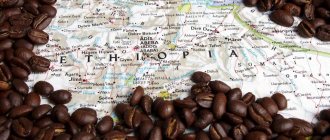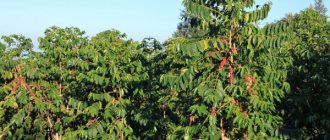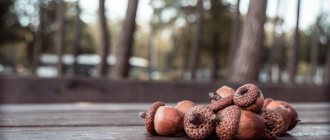COFFEE TREE,
coffee (
Coffea
), a genus of evergreen shrubs or small trees of the madder family (Rubiaceae).
Counts approx. 40 species, of which 19 are commercially important, but only three - the Arabian ( C. arabica
), Liberian (
C. liberica
) and powerful (
C. robusta
) coffee trees - produce export coffee beans used to prepare the popular tonic drink coffee .
Its name comes from the Arabic word "qahwa", meaning "wine". The bulk of coffee beans on the world market are seeds of various varieties of the Arabian coffee tree. It is a shrub or tree 4.5–6 m high from the tropics of Asia and Africa. In cultivation, it is pruned to a height of 1.8–2.7 m to facilitate harvesting. The bark is thin, gray; leaves are opposite, dark green, glossy. Fragrant white flowers, similar to jasmine flowers, are collected in groups in the axils of the leaves. The fruits are elliptical red or violet-blue berries with a thin layer of sticky, juicy, sweet pulp and two seeds adjacent to each other on their flat sides. They are covered with a thin silvery peel and a parchment shell: these covers, along with the pulp, are removed before roasting the seeds. Abnormal single-seeded fruits, called "man berries" or "peas", usually develop at the ends of branches. Different types of coffee beans vary in caffeine content, which ranges from 0% for the humboltiana
from Grande Comore to 2.9% for the Extra Medellin variety grown in Colombia.
It takes about one and a half coffee beans to prepare one cup of drink. Also on the topic:
PLANT SYSTEMATICS
Basic chromosome number of the genus Coffea
(n) is 11. Diploid (n = 22) and tetraploid (n = 44) species of this genus are also known. Through hybridization it turned out to be possible to obtain various combinations of hereditary properties.
History of coffee.
According to legends, the drink coffee appeared in Arabia before the 13th century. They say that one Arab mullah, having noticed how goats, having eaten the leaves and berries of the coffee tree, began to jump excitedly over the hills, began to give an infusion of coffee beans to his students so that they would not fall asleep during evening prayer. In the 16th and 17th centuries. coffee spread to Persia, Turkey, Europe and America. This drink began to accompany many ceremonies. Some peoples serve coffee as a sign of hospitality. Bedouins pour four sips into a cup as a sign to the guest: “Drink and leave.” In the East, coffee houses surpassed mosques in popularity and were banned in some places. The first European country to start drinking coffee was Italy. Soon after, "cafes" appeared throughout Europe. Charles II closed 3,000 coffee shops in England, calling them “rebel schools,” but within a few days he was forced to revoke his edict under pressure from public opinion.
In which countries does coffee grow?
Today, there are quite a lot of coffee-growing countries, among them the following stand out:
- Australia;
- Angola;
- Belize;
- Bolivia;
- Botswana
- Brazil;
- Venezuela;
- East Timor;
- Vietnam;
- Haiti;
- Guyana;
- Guatemala;
- Guiana;
- Honduras;
- Dominican Republic;
- DR Congo;
- Zambia;
- Zimbabwe;
- India;
- Indonesia;
- Yemen;
- Cambodia;
- Cameroon;
- Kenya;
- China;
- Colombia;
- Costa Rica;
- Cote d'Ivoire;
- Cuba;
- Laos;
- Madagascar;
- Malaysia;
- Mali;
- Mexico;
- Myanmar;
- Nicaragua;
- Saint Helena
- Panama;
- Papua New Guinea;
- Paraguay
- Peru;
- Puerto Rico
- Salvador;
- Suriname;
- Thailand;
- Tanzania;
- Trinidad and Tobago
- Uganda;
- Philippines;
- Ecuador;
- Ethiopia;
- SOUTH AFRICA;
- Jamaica.
Does coffee grow in Italy and Turkey?
Many coffee gourmets wonder whether coffee is grown in Turkey and Italy or not, and this is not without reason. We have all heard more than once about making Turkish coffee, Italian espresso and other coffee drinks. All this creates a picture in the subconscious that these countries are dotted with coffee plantations, but this is not entirely true.
Coffee does not grow in Italy or Turkey
. This is due to the climatic characteristics of the two countries. The coffee tree loves hot and humid climates and does not tolerate low temperatures; in a word, it grows only in the tropics.
However, these countries import green coffee and roast it and prepare drinks themselves. Italy specializes in coffee blends, and its Lavazza brand is popular all over the world.
What is better to choose: Arabica or Robusta, as well as about the similarities, differences and taste characteristics of the two varieties, read here.
Those who love drinking coffee should know everything about its shelf life. This information is available here.
Cultivation.
The “coffee belt” corresponds to a strip approximately 20° wide on each side of the equator and extends from 0 to 1520–1830 m above sea level. The coffee tree grows best and produces the highest quality beans at an average annual temperature of 20° C and an annual rainfall of 1000–1800 mm. Plants grown from selected seeds begin to bear fruit at the age of five, and produce the best harvest at 8–15 years. Each tree produces 0.45–3.6 (in exceptional cases up to 5.4) kg of grains per year. Some specimens continue to bear fruit up to a hundred years of age.
Care
In indoor cultivation, coffee is unpretentious, develops well and over time turns into a spreading, fairly tall tree, occupying almost the entire windowsill. In order to successfully raise a green pet and harvest aromatic grains from it, two main conditions must be met - warmth (but not more than 30 ° C) and bright, diffused light.
REFERENCE! The plant loves fresh air, so in the warm season it can be placed on a balcony or veranda, but always with light shading. It is necessary to protect coffee from drafts.
Of course, the coffee tree deserves to live in your home greenhouse.
The plant is unpretentious and caring for it will only bring pleasure. And most importantly, you will acquire not only a charming and fragrant decoration for your home, but also your own “coffee plantation.”
Also on our website you will find a lot of interesting information about such fruit trees as: Ardisia, Lemon tree, Mango, Feijoa, Orange, Pomegranate, Dwarf banana.
Collection and processing.
The fruits of the coffee tree are harvested by hand: combing the branches with a special comb or plucking one berry at a time. The time and synchronicity of their maturation depends on temperature. In Brazil, the harvest sometimes lasts from May to September. The availability of water determines whether grains are cleaned using the “dry” or “wet” method. The second of them is economically preferable: the fruits are soaked overnight in tanks, and then sent along with water for mechanized “peeling” by friction. After this, the remaining slimy pulp is fermented in other tanks and washed off. The grains, still covered with a parchment shell, are dried for 10 days in the sun (taking them indoors at night) or 24 hours with hot air (this allows for better control of the process). Then the parchment and silver shells are peeled off by friction and the grains are sorted by size. Green beans lack a pleasant taste, so they are roasted to create the aromatic oil caffeol.
Coffee beans can be decaffeinated with organic solvents such as methylene chloride or ethyl acetate, hot water or steam. In practice, it is customary to extract approximately 97% of the caffeine from them. After the decaffeination agent is removed, the beans are dried, roasted, sold as such or ground, or further processed into instant and freeze-dried coffee, which are obtained from a concentrated ground extract. In the case of regular instant coffee, water is removed from the extract by evaporation in a spray dryer; in the case of lyophilized coffee, by freezing and sublimation.
Coffee beans are very sensitive to oxygen, so they are best consumed immediately after roasting and grinding, but if adequately packaged, they will remain high quality for at least several months. In some places it is customary to add chicory to ground coffee.
Arabian coffee tree
Branch with flowers and unripe fruits;
1 - unfolded rim; 2 - stamens; 3 - pestle with cup; 4 — ovary in longitudinal section; 5 and 6 - seed from the dorsal and ventral sides; 7 — fruit in cross section; 8 — seed in cross section; 9 — the same with the embryonic root shown; 10 - root of the embryo.
The coffee beans we are used to are produced by the coffee tree. It belongs to the madder family (Rubiaceae), which includes about five thousand plant species. Among them, the coffee genus accounts for about 60 species, including:
- 33 species have been discovered in Africa,
- on the islands of Mauritius and Reunion - 3,
- in Southeast Asia - 10,
- on the island of Madagascar - 14.
These are quite diverse plants: among them there are deciduous, evergreen, and mighty tall trees and shrubs. However, they all have one thing in common - the presence of caffeine in the seeds and leaves.
The fruit has a tough outer skin (exocarp), under which there is a juicy yellowish pulp (mesocarp). The pulp envelops paired hemispherical seeds, which are enclosed in a greenish parchment shell (endocarp).
The so-called pea berry contains only one seed. There are also “elephants” - flat coffee beans fused in pairs and 3-4 or more seeds in the fruits of the polysperma mutant.
Of all the types of coffee trees, only Arabian coffee, or Arabica (Coffee Arabica), Congolese coffee, or Robusta (Coffee Canephora), are economically important. Liberian coffee, or Liberica (coffee Liberica), and high coffee (coffee Dewevref) are also of minor economic importance.
↑ up
Products.
At the end of the 17th century. The Dutch introduced the coffee tree to Java, thereby laying the foundation for the East Indian coffee trade. Nowadays the coffee tree is also grown in many countries of the Western Hemisphere. There are between four and five billion coffee trees in South America; most of them are the offspring of seedlings brought to the island of Martinique at the beginning of the 18th century. the Frenchman Declier, specially sent there for this purpose by Louis XIV. Dekliye was so zealous about his mission that he saved most of the trip on water - just so that the plants would survive. From Martinique, seedlings came to French Guiana, and in 1722 to the Brazilian state of Pará. At the end of the 18th century. The Belgian monk Molke brought coffee seedlings to Rio de Janeiro.
The coffee tree is grown in almost all tropical and subtropical countries. The largest producers are Brazil, Colombia, Indonesia, Cote d'Ivoire, Ethiopia, Mexico, Guatemala and India.
Kinds
Only a few coffee trees are grown at home, among them the following types are popular:
- Arabica, otherwise Arabic or Arabian, in Latin Coffea arabica is the most popular species, occupying 90% of the area of all the world's coffee plantations. It is Arabica that is most popular in indoor culture. In shape it is a spreading tree with long and flexible branches. The leaves of the plant are dark green with a shiny corrugated surface, reaching a length of 15 cm. In nature, its height is from 5 to 8 meters, and when grown indoors - from 1 to 1.5 meters. Based on Arabica, the dwarf form Nana was developed, which is most adapted to indoor keeping. It takes up little space, blooms profusely and bears fruit well;
- Robusta or Congolese, in Latin Coffe robusta, - the name of the plant translates as “powerful” or “strong”. Trees of this species are long-lived, tall (up to 10 meters in height), and are unpretentious and highly resistant to disease. They grow well in intense heat in flat conditions where Arabica cannot grow. However, in terms of the quality of the resulting grains, Congolese is inferior to Arabian, occupying only about 30% of the total world production. The plant differs from its relatives not only in height, but also in large foliage up to 32 cm in length and up to 8 cm in width. The underside of the leaves is slightly pubescent. Fragrant snow-white flowers are decorated in the center with a light brown star. Robusta beans are used mainly for the production of instant coffee or mixed with Arabica to give the drink a more pronounced and strong taste;
- Liberica or Liberian, in Latin Coffea liberica, is a much less commonly cultivated species with large leaves, up to 40 cm in length. The upper side of the foliage is dark green, while the lower side is lighter. Liberian coffee is resistant to almost all diseases of coffee trees, it is only afraid of rust fungus. However, Liberica fruits are not of high quality and have a bitter and less refined taste. They are used only in confectionery production and to create coffee mixtures;
- Excelsa, otherwise tall, in Latin Coffea Excelsa, is an even less common species than Liberica. Coffee grows in countries such as the Philippines, Kenya, Venezuela and Vietnam. In nature, Excelsa trees are very tall - up to 20 meters. The plant has a lush and dense crown with thinner leaves, the tip of which is not pointed, but rounded. The young leaves of the tree are initially purple in color, then turn green as they grow. High coffee is resistant to diseases of coffee trees, but is very demanding in care, requiring special growing conditions. It is necessary to choose soil for a coffee tree of this variety with a rich organic composition and high humidity. Excellium has no industrial significance, since its fruiting is not constant and it is very difficult to predict the yield. Nevertheless, its fruits are highly valued. They are distinguished by their larger size and unusual rich aroma. Excelsa grains in their pure form are not used. They are supplemented only with elite coffee blends to obtain unique flavors.
Usage.
The main product obtained from coffee beans is a drink, i.e. actual coffee. In recent decades, the share of instant coffee consumed in the United States and other economically developed countries has fallen sharply. This is associated with a change in the taste standards of the population and fear of widespread surrogates. At the same time, there was a decrease in the share of consumed decaffeinated coffee. People have become less afraid of the harmful effects of caffeine, and in addition, there are reports that even decaffeinated coffee increases cholesterol levels in the blood.
Coffee is also used as a flavoring component in baked goods, ice cream, candies and liqueurs.
How to propagate a tree?
Ordinary green grains from which the drink is prepared are not suitable for propagation. They are stored for a long time and undergo special processing. The best germination rate is for grains collected no later than 1.5 months ago. But the best option is to take a ripe berry. When growing, you need to maintain a temperature from +19°C to +24°C.
They are planted in peat mixed with coarse river sand and turf soil (1:1:2). The soil is prepared 14 days before planting the seeds. Immediately before the procedure, it is sterilized - kept for 10 minutes. over the vapor of boiling water. Before sowing, the grains must be kept in a weak solution of potassium permanganate and aloe juice.
The berries are placed in a damp hole on their side, flat side down. Sprinkle the top with earth and lightly compact it, water it, and cover it with film or glass. The seeds are placed on the surface, slightly pressed into the soil (if deep, they will begin to rot). The pot is placed in a well-lit, warm place, excluding the plant from exposure to the sun's rays.
Coffee grows (the photo shows how to plant it correctly) from berries in 3-6 months, from beans it takes less time - from 30 to 90 days. The sprouts are kept under glass or film covering until they shed their hard shell. Condensation is periodically washed off. Twice a week, remove the glass or film for 3 hours to ventilate the soil.
For propagation by cuttings, soil is taken from river sand and peat (in equal parts 1:1). The branches (cut obliquely 3 cm below the bud, with two leaves) are soaked in any growth stimulator for 4-5 hours. Then they are stuck into holes 3 cm deep, previously filled with coarse sand.
The cuttings are covered with a plastic bag with slits. They are made for ventilation and water infiltration during spraying. Plant as soon as 2 new leaves appear on the branch.
The easiest way is to buy ready-made seedlings in a specialized store. They should have shiny dark leaves, maybe with flowers or berries. But in stores, seedlings are often overfed with fertilizers. Therefore, after planting, the tree may turn yellow and lose its leaves. But as soon as she receives normal care, she recovers.
Classification of coffee by roast type
Coffee can be green or roasted. To prepare our usual drink, roasted grains are used. There are several basic types of heat treatment of grains, with additional gradation in degree.
- Light roast . Produced until the first click of the grain or a little longer. The beans are light or variegated in color, the cracks on them are weak or barely noticeable, and the coffee aroma is average. Well suited for high-mountain coffees that have high hardness but a loose structure. In light roasting there are three degrees - Scandinavian, American, and partial city.
- Medium roast . Popular due to its versatility. This is done until the second click of the grain or a little longer, until the first oil traces appear on the grains. Suitable for many varieties from Central and South America, Africa. Has two degrees: full city and Viennese.
- Deep roast . Lasts after the second crack of the grain until the grains become caramelized and dark brown. Suitable for Cuban, Guatemalan varieties, some types of coffee from South America and some African varieties. The first degree of deep roasting is called French or Turkish, the second – continental.
- The highest degree of roasting , in which the beans acquire a very thick, black-brown color. It is suitable for some types of coffee from Cuba, Mexico, and India.
Italian roasting is distinguished as a separate type due to the peculiarities of the technology. The grains are cooled with compressed air, sometimes fried twice. Italian roasting is typical for Robusta, blends and espresso blends.
Classification of coffee by preparation method
The inhabitants of our planet drink approximately 500 billion cups of coffee per year. All coffee consumed is divided into types according to the method and recipe of preparation. We have written a lot about specific cooking methods, so as not to repeat ourselves, we will reduce the recipes to several basic groups.
- Oriental coffee. It is prepared in a cezve over an open fire or in hot sand.
- Espresso. Prepared in an automatic coffee maker or geyser coffee maker.
- Black coffee, which is prepared in a drip or carob coffee maker. Maybe it has some special name, but we couldn't find it.
- Alternative coffee. It is prepared in a pour over, Chemex, Aeropress, infused in a French press or directly in a cup.
All these types of natural coffee are basic; hundreds of other drinks and cocktails are prepared on their basis.
We have collected the main classifications of coffee. If you missed something, add it in the comments.
Recommendations for self-cultivation
Coffee grows (the photo shows what a healthy tree should be like) without special additional conditions - on the floor in tubs, on window sills. It is easy to care for. If everything is done on time and correctly, then the first flowering is observed already in 3-4 years.
In order for a tree to bear fruit, it must be wintered. Three basic rules of care: watering, fertilizing with fertilizers and organic matter, and replanting. To achieve a beautiful crown, install a mirror opposite the tree, but do not allow the sun's rays to be reflected on the plant.
Air temperature
The plant in spring and summer should be at a temperature from +23°C to +25°C. The first value is considered optimal. In winter, the temperature in the room or balcony where the tree stands should be from +15°C to +17°C.
If it is not possible to take it out to a closed loggia, then place the pot on the windowsill and close the radiator, blocking the flow of heat. You can limit it with a fence to direct it only indoors.
Lighting
The tree does not tolerate heat and scorching sun. Under such conditions it will not bloom. The tree is placed in a well-lit place, but shaded from the sun. If the pot is located near the south window, then it is moved to a distance of 1.5 m. Additional lighting is required only when the tree is in a dark corner or during short winter days.
Watering
From May to October (especially in the summer months), the tree is sprayed daily with settled water from a spray bottle. Once every 30 days, an ash solution is added to it. This is necessary to prevent diseases and pests. Dust and dirt from the leaves are washed off with a damp cloth.
The tree can be watered from the shower once a month. In winter it does not need spraying.
The plant loves moist soil, but if there is too much water, the roots will begin to rot. To prevent this, drainage material (for example, nut shells) is poured onto the bottom of the pot. You can tell that a tree is suffering from a lack of moisture by its drooping and limp leaves. After watering, they immediately rise and straighten out.
The frequency of watering is determined by humidity and temperature in the house. The water is first left to sit for a day. Water the soil when its surface is 1 cm dry. If the room is very warm, it is enough to moisten the soil a couple of times a week, and in winter - once a week.
How to feed correctly?
The coffee tree needs good feeding. It is best suited for ready-made complex fertilizers, organics (for example, Sapropel mud), intended for indoor flowers or with chicken droppings. During flowering, water 1-2 times with a solution of water with ash from straw enriched with potassium.
From March to November it is recommended to apply one fertilizing every two weeks, then until February – once a month. From March to June, the tree is fed with nitrogen fertilizers. Then mineral and organic are added once each.
In summer, monosubstituted potassium phosphate is used at intervals of 10 days. But organics are excluded. In September, the soil is fertilized with potassium salts, spraying the crown with the solution.
Citric acid is injected into the soil monthly to increase the pH. A bucket of water requires 1 g of powder or 2-3 tsp. natural juice. The leaves are wiped with the same solution if they become dull.
How to transplant correctly?
The coffee tree does not tolerate any movement. Therefore, it is not recommended to rearrange it; if necessary, then no more than once every 5 years. Frequent transplantation is not required. The longer the tree is in one pot, the better the horse system develops. The need for replanting is determined when the roots have already completely densely filled the flowerpot.
Before transplanting into another pot, remove dried, rotten shoots.
Then fill the bottom with drainage and earth so that the root neck rises above the surface by 5-7 mm. The remaining space is filled with fresh substrate. Then water it with soft water, the temperature of which should be slightly above room temperature. After a couple of days, lightly loosen the soil.
If it has settled a little, add manure humus or weathered peat. Up to three years of age, transplantation is carried out annually, then once every 2-3 years. The event is scheduled after the harvest, before the next flowering (this is approximately 30 days).
Trimming
More often the tree grows in a standard form. It does not particularly require pruning, only if it is necessary to remove dry and damaged branches or give the crown the desired shape. If you don’t form the trunk yourself, the tree can grow spherical.
In the first 12 months, the shoots are not touched. If you want to get a tree with a dense crown, then after the trunk becomes 25-30 cm high, it is tightly tied with wire at a level of 15-20 cm, a centimeter below the internode.
You can trim so that 2 remain. The top shoot is pinched. Then all the branches that go up from the wire are cut off, and the rest are shaped as desired. After 3-4 years, the wire is weakened and removed after a month. It is not recommended to prune standard trees, otherwise it may stop growing.
Rest period
Around October, when the cold weather sets in, the tree is given a rest. It is moved to a room with a temperature from +12°C to +15°C. Water during rest only when the top layer of soil is dry. Additional lighting is provided for it for 4-5 hours a day. At the end of February or early spring they begin to bring it into the room. Once the desired temperature is reached, leave it in the room.











